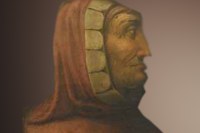‘Copia legum’. With this epitaph, the dying Irnerio, in the imaginative words of the judge from Lodi, Ottone Morena, last salutes the scholar Martino Gosia, as he stood next to him alongside his other three disciples, Bulgaro, Iacopo and Ugo di Porta Ravegnana. Compared to the others, Martino, the connoisseur “of many laws”, succeeded in combining the Roman Law of the Corpus Iuris Civilis with Canon and Germanic Law.
 Rejecting a long tradition initiated by the chronicles of Giovanni da Cremona (12th-13th century), who would have Martino as a native of Cremona and traces the name Gosia back to a typical local surname, far more convincing is the testimony of Piacentino, a student in Bologna at the time of Martino himself, and of other jurists who frequented the University in the following centuries (Gugliemo da Pastrengo and Cino da Pistoia), who would have the famous master as a native of Bologna.
Rejecting a long tradition initiated by the chronicles of Giovanni da Cremona (12th-13th century), who would have Martino as a native of Cremona and traces the name Gosia back to a typical local surname, far more convincing is the testimony of Piacentino, a student in Bologna at the time of Martino himself, and of other jurists who frequented the University in the following centuries (Gugliemo da Pastrengo and Cino da Pistoia), who would have the famous master as a native of Bologna.
Martino, together with Bulgaro, Iacopo and Ugo di Porta Ravegnana, was a scholar of Irnerio, the initiator of the renowned School of Glossators, of which the four became the illustrious successors.
The method of the glosse, annotations placed in between the lines and in the margins of manuscripts, was much practised by Martino, who from 1125 produced a conspicuous quantity of references and cross-references, not only of the main text of the University of Bologna, the Corpus Iuris Civilis, but also of texts of Canon Law and Longobard Law. The most extensive and complex work by Martino, which by far surpasses the works of his contemporaries, is De iure dotium, a true treatise on the always difficult subject of dowry law. After exhaustively illustrating the theoretical directives expounded in the Justinian corpus, Martino does not conceal his disagreement in the conclusions, elevating the legitimacy of equity above all legal principles: a value that, according to his way of thinking, does not stem from the law but from the individual judge's ability to evaluate.
This supreme value, disregarded by the more orthodox Bolognese jurists, characterised his teachings, which soon resulted in the establishment of a particularly distinguished Gosian school, often antagonistic to the one created by his colleague Bulgaro, which was disinterested in ecclesiastical and Germanic laws and absolutely adherent to Roman law alone.
This rivalry gave the city's University greater prominence, as it allowed its many foreign scholars to choose between different pedagogical and doctrinal thoughts.
Like his fellow teachers, Martino was not only considered a legis doctor, i.e. a teacher of the law, but also a causidicus, i.e. an advisor in public and private disputes, and even in these circumstances he often managed to make his idea of equity prevail.
A two-way relationship had been established between Emperor Barbarossa and the nascent Alma Mater Studiorum since the Swabian's arrival in Bologna in 1155. On this occasion, the four disciples, together with the governing bodies of the scholars, succeeded in persuading Barbarossa to grant students his protection, to declare them independent of local powers and jurisdiction, and thus to make university teaching and education free. This epochal achievement was sanctioned by the Constitutio Habita, a privilege that was included in the Corpus Iuris Civilis probably in 1158 during the Diet of Roncaglia, when the Emperor himself summoned the 'four disciples' to legally certify his authority over Italian cities.
According to an anonymous poet, probably a follower of Martino’s, after a long period of activity he decided to retire from teaching and to offer his advice free of charge, leaving his professorship, as was often the case, to his son Guglielmo.
It is fairly certain that he died shortly after his rival Bulgaro, around 1166, and that the two were buried next to one another, in the churchyard of the church of San Patroclo, a historic place of worship whose Benedictine monastery was used for the assemblies of law students from abroad.
While in Bologna his legacy was not regarded as highly as that of the other three disciples, partly due to the parallel School of Graziano, which offered a more in-depth teaching of Canon Law. Through his pupil Piacentino, Martino's precepts were more greatly accepted in the Law Schools of Montpellier and later in those of Northern France, where Gosia’s equity found a more fertile ground in which to flourish.
